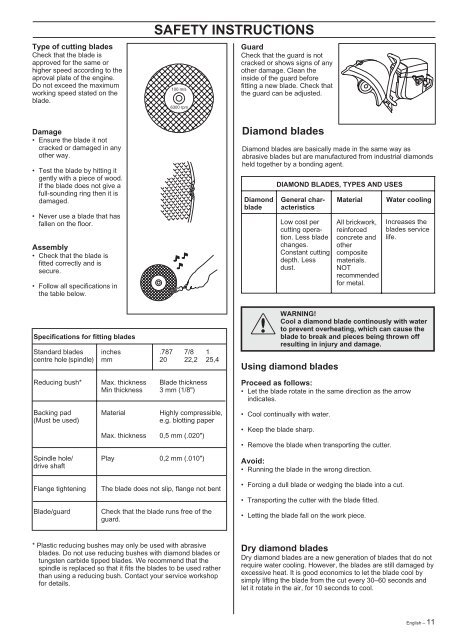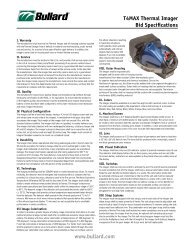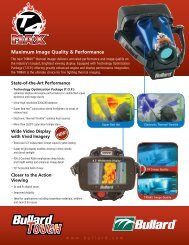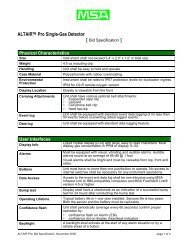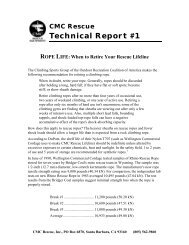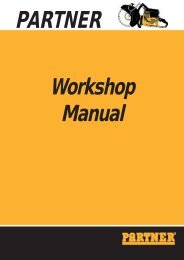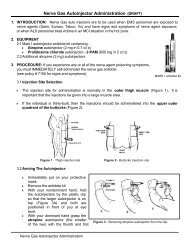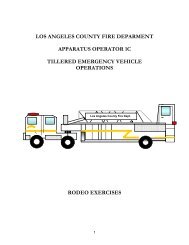PARTNER K950 Operators Manual 1998.pdf
PARTNER K950 Operators Manual 1998.pdf
PARTNER K950 Operators Manual 1998.pdf
Create successful ePaper yourself
Turn your PDF publications into a flip-book with our unique Google optimized e-Paper software.
Type of cutting blades<br />
Check that the blade is<br />
approved for the same or<br />
higher speed according to the<br />
aproval plate of the engine.<br />
Do not exceed the maximum<br />
working speed stated on the<br />
blade.<br />
Damage<br />
• Ensure the blade it not<br />
cracked or damaged in any<br />
other way.<br />
• Test the blade by hitting it<br />
gently with a piece of wood.<br />
If the blade does not give a<br />
full-sounding ring then it is<br />
damaged.<br />
• Never use a blade that has<br />
fallen on the floor.<br />
Assembly<br />
• Check that the blade is<br />
fitted correctly and is<br />
secure.<br />
• Follow all specifications in<br />
the table below.<br />
SAFETY INSTRUCTIONS<br />
100 m/s<br />
6300 rpm<br />
Guard<br />
Check that the guard is not<br />
cracked or shows signs of any<br />
other damage. Clean the<br />
inside of the guard before<br />
fitting a new blade. Check that<br />
the guard can be adjusted.<br />
Diamond blades<br />
Diamond blades are basically made in the same way as<br />
abrasive blades but are manufactured from industrial diamonds<br />
held together by a bonding agent.<br />
DIAMOND BLADES, TYPES AND USES<br />
Diamond General char- Material Water cooling<br />
blade acteristics<br />
Low cost per<br />
cutting operation.<br />
Less blade<br />
changes.<br />
Constant cutting<br />
depth. Less<br />
dust.<br />
All brickwork,<br />
reinforced<br />
concrete and<br />
other<br />
composite<br />
materials.<br />
NOT<br />
recommended<br />
for metal.<br />
Increases the<br />
blades service<br />
life.<br />
Specifications for fitting blades<br />
Standard blades inches .787 7/8 1<br />
centre hole (spindle) mm 20 22,2 25,4<br />
Reducing bush* Max. thickness Blade thickness<br />
Min thickness 3 mm (1/8")<br />
Backing pad Material Highly compressible,<br />
(Must be used)<br />
e.g. blotting paper<br />
Max. thickness 0,5 mm (.020")<br />
Spindle hole/ Play 0,2 mm (.010")<br />
drive shaft<br />
!<br />
WARNING!<br />
Cool a diamond blade continously with water<br />
to prevent overheating, which can cause the<br />
blade to break and pieces being thrown off<br />
resulting in injury and damage.<br />
Using diamond blades<br />
Proceed as follows:<br />
• Let the blade rotate in the same direction as the arrow<br />
indicates.<br />
• Cool continually with water.<br />
• Keep the blade sharp.<br />
• Remove the blade when transporting the cutter.<br />
Avoid:<br />
• Running the blade in the wrong direction.<br />
Flange tightening<br />
Blade/guard<br />
The blade does not slip, flange not bent<br />
Check that the blade runs free of the<br />
guard.<br />
• Forcing a dull blade or wedging the blade into a cut.<br />
• Transporting the cutter with the blade fitted.<br />
• Letting the blade fall on the work piece.<br />
* Plastic reducing bushes may only be used with abrasive<br />
blades. Do not use reducing bushes with diamond blades or<br />
tungsten carbide tipped blades. We recommend that the<br />
spindle is replaced so that it fits the blades to be used rather<br />
than using a reducing bush. Contact your service workshop<br />
for details.<br />
Dry diamond blades<br />
Dry diamond blades are a new generation of blades that do not<br />
require water cooling. However, the blades are still damaged by<br />
excessive heat. It is good economics to let the blade cool by<br />
simply lifting the blade from the cut every 30–60 seconds and<br />
let it rotate in the air, for 10 seconds to cool.<br />
English – 11


